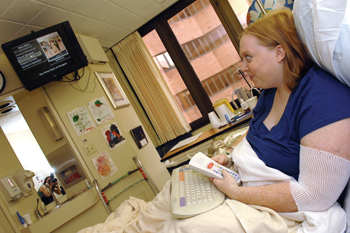
Patient Sandy Towle uses the new Skylight Access Interactive Patient System in her hospital room on 8 South. The new system includes television/entertainment, hospital information, patient education, Internet access, games and more. (photo by Dana Johnson)
VUH’s television system tunes in major upgrade
A new television system is being installed in Vanderbilt University Hospital patient rooms, complete with pay-per-view movies, a choice of English or Spanish, and an interactive feature that allows patient education and surveys.
“The basic platform is just like you have in a hotel room,” said Terrell Smith, director of Patient and Family Centered Care.
Installation of the new system began several months ago, and is scheduled to be completed within the next few weeks, Smith said.
“We had to pull cable and rewire every room in the hospital,” she said.
Every set now comes with a wireless keyboard that allows patients and families to check e-mail, and a remote allowing them to select from a channel menu similar to that offered by cable or satellite programmers, including pay-per-view movies.
“The only thing [patients] pay for on the whole system is movies — $6.95 for 24 hours of unlimited movies,” she said.
The movies are “airline-scrubbed,” so they are suitable for all ages to view, and can be paused — an important consideration in a hospital, where a two-hour window to watch a movie uninterrupted is rare. The system will contain about 30 movies, which will be changed quarterly.
Money raised from the pay-per-view movies will go into a special fund for patient-education videos, which patients can select and view to learn about a treatment or condition.
The system will also display a video for patients upon check-in, which will welcome them to Vanderbilt and provide orientation and safety information, and will allow real-time patient surveys at 24 and 72 hours into a stay.
“It will be a short survey that says, 'You've been here 24 hours, tell us how we're doing, are you happy with your care,'” Smith said.
“This allows us to know about and help with issues while the patient is still here.”













